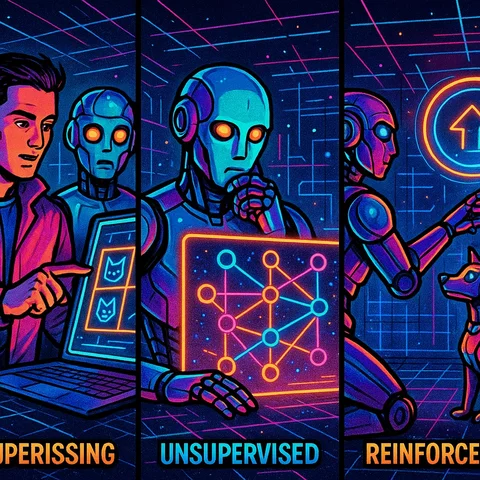Large Language Models (LLMs): Recent Advancements in Architecture & Training
Explore the latest developments in LLM architectures and training techniques, and understand how they are shaping AI and NLP today.

Large Language Models (LLMs): Recent Advancements in Architecture & Training
Introduction to Large Language Models
Large Language Models (LLMs) are at the forefront of artificial intelligence (AI), transforming how machines understand and generate human language. These models leverage deep learning techniques, primarily transformer-based architectures, to perform tasks such as text generation, translation, summarization, and complex reasoning. Trained on billions of diverse online documents, LLMs like GPT, BERT, and PaLM have become essential tools across industries, from healthcare to finance, enabling more natural and efficient human-computer interactions.
Evolution of LLM Architectures
What Are Large Language Models?
LLMs are sophisticated AI systems designed to grasp the nuances of human language. Unlike earlier models with limited capacity, modern LLMs can process vast amounts of data to produce contextually relevant responses, making them invaluable for natural language processing (NLP) applications.
Transformers and Beyond: Architecture Innovations
Since their introduction in 2017, transformer architectures have revolutionized NLP by enabling parallel processing of input data, vastly improving training efficiency and scalability. Models like GPT-4 and Google's PaLM 2 exemplify this progress, pushing the boundaries of what LLMs can achieve.
Recent innovations include the Chain-of-Model Learning (CoM) paradigm, which incorporates causal relationships into the hidden states of models. This approach enhances reasoning capabilities and inference flexibility, addressing some limitations of traditional transformer models (Analytics Vidhya, 2023).
Key Research Findings
The rapid evolution of LLM architectures is evident in the increasing complexity and capacity of models, with some reaching hundreds of billions of parameters. This scaling correlates with improved performance across NLP tasks, although it also introduces challenges related to computational costs and energy consumption.

Key Training Techniques for LLMs
Supervised, Unsupervised, and Reinforcement Learning
Training techniques for LLMs have diversified to optimize performance and efficiency:
- Supervised Learning: Involves labeled datasets for tasks like translation or question-answering.
- Unsupervised Learning: Most foundational to LLMs, where models learn from raw, unlabeled data, capturing language patterns.
- Reinforcement Learning: Used in fine-tuning models like GPT-4, where models learn through reward signals to improve response quality and safety.
Scaling Laws and Model Size
Research indicates a strong correlation between model size and performance, following established scaling laws. Larger models tend to excel in few-shot and zero-shot learning, demonstrating versatility in various NLP tasks (OpenAI, 2023).
Fine-tuning and Prompt Engineering
Post-training, LLMs often undergo fine-tuning to adapt to specific tasks or domains. Techniques like prompt engineering further enhance their utility, enabling more precise and context-aware outputs without extensive retraining.
Emerging Architectures and Techniques
Innovations such as the Mixture-of-Experts (MoE) transformer models, like DeepSeek, optimize computational resources by activating only parts of the model as needed, reducing costs while maintaining high capabilities (ScienceDirect, 2023).
Recent Breakthroughs and Innovations

Advances in Model Architecture
Emerging architectures, including sparse activation and multimodal models like Google DeepMind’s Gemini, which processes text, images, and code simultaneously, are broadening the scope of LLM applications.
Challenges and Limitations
Despite significant progress, LLMs face hurdles such as high computational costs, biases in training data, and issues related to interpretability. Addressing these challenges remains a priority for researchers.
The Role of Data Quality and Quantity
Data remains the backbone of LLM performance. High-quality, diverse datasets are essential for training models that are robust, fair, and capable across languages and domains.
Impacts of LLM Advancements
Impact on NLP Applications
Recent advancements have dramatically improved NLP tasks, enabling more accurate chatbots, real-time translation, and sophisticated content generation. The market for LLMs is projected to grow from $4.5 billion in 2023 to over $82 billion by 2033, reflecting their expanding influence (Hostinger, 2025).
Broader AI and Industry Implications
Beyond NLP, LLMs are catalyzing innovation in areas like computer vision, code generation, and drug discovery, showcasing their versatility and transformative potential.
Future Trends in LLM Development
Predictions for Future LLM Research
The trajectory points toward even larger, more efficient models that integrate multimodal data, leverage self-supervised learning at scale, and incorporate ethical safeguards. Research into modular and adaptive models promises to enhance flexibility and reduce resource requirements.
Internal Links & Further Reading
For a more detailed understanding of popular LLMs, explore 7 Popular LLMs Explained in 7 Minutes. To stay updated on the latest AI breakthroughs, subscribe to our newsletter and access comprehensive guides on building and training your own LLMs.
At a Glance
- Transformer models remain the foundation of modern large language models, enabling unprecedented scalability and performance.
- Innovative training techniques, including fine-tuning and prompt engineering, significantly enhance LLM utility.
- The market for LLMs is booming, expected to reach over $82 billion by 2033.
- Emerging architectures like Mixture-of-Experts and multimodal models are expanding the horizons of AI capabilities.
- Challenges such as high computational costs and data biases continue to drive research into more efficient and ethical models.
Large Language Models are rapidly evolving, shaping the future of AI and natural language processing. To stay at the forefront of these developments, subscribe to our updates and explore our detailed tutorials on building and fine-tuning LLMs.
- KDnuggets: 7 Popular LLMs Explained in 7 Minutes
- ScienceDirect: LLM Applications and Challenges
- arXiv: Recent Advances in LLMs
- Hostinger: LLM Market Statistics
Ready to dive deeper? Subscribe now for the latest updates on AI advancements and access exclusive guides on building powerful LLMs.


